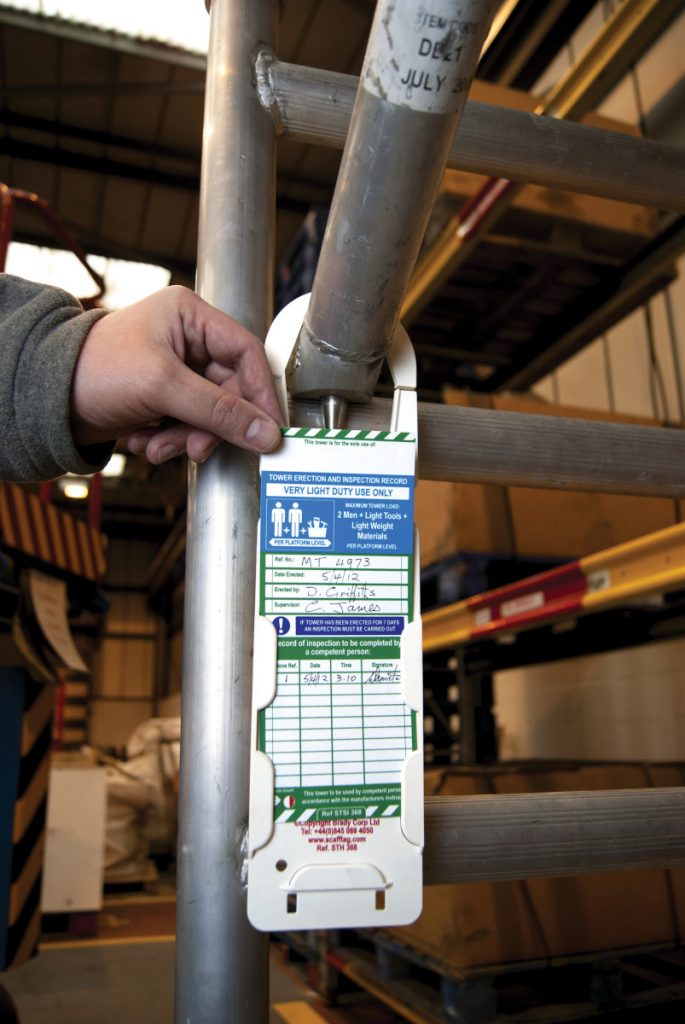
Making safety culture visible at T5 with Scafftag
How can you ensure shared information on the status of a scaffold is instantly available to all employees from all parties in a challenging T5 project? Scafftag has the answer…
No question, the scale of the T5 project is impressive and challenging. 16 major projects and 147 sub-projects make it one of the most talked about developments in the industry. But it is not only the size of the project that has attracted so much attention. The innovative approaches to safety employed have hit the headlines too.
BAA, which owns six other major UK airports as well as Heathrow, has focused on creating a proactive safety culture across all operations. This culture is intently participative rather than prescriptive. In 2000, BAA launched its renowned ‘One in a Million’ campaign to set a challenging target for the reduction of reportable injuries. As the name suggests, the campaign involves an ongoing benchmark target of only one reportable accident per million hours worked.
As an addition at T5, it has introduced its ‘Incident and Injury Free’ (IIF) programme. The idea of IIF is to make everyone on site responsible for safety – including for their colleagues.
The ultimate objective is to create an incident free site. Achieving this culture requires a strong degree of partnership amongst suppliers working on the project.
Specified Scafftag Systems
BAA already uses a custom designed Towertag system for managing its mobile towers on all other Heathrow terminals and its other airports. However, due to the scale of the project and number of contractors, an even wider range of Scafftag systems is in operation on T5.

Scafftag used by all contractors
The Scafftag scaffold tagging system has been specified by the T5 project team to be used by all contractors operating the vast structures which are in place. This helps to ensure shared information on the status of the scaffold is instantly available to all employees from all parties. It means individuals can make informed decisions about the safety of the structure. This reinforces the culture of everybody taking ownership for safety.
Safetrak improves efficiency
The Safetrak system is also in use at T5 to move all scaffold inspection processes into a paperless, automated format. Inspection information is electronically transferrable between the equipment tagging systems and handheld computers using RFID (Radio Frequency Identification) technology. The information is then synchronised and centralised by the Safetrak software.
Microtag adds protection
Beyond scaffolding, the Microtag system has also been specified to all T5 contractors to help control HAVS (Hand Arm Vibration Syndrome). A Microtag® is attached to portable tools subject to HAVS in order to indicate the maximum daily usage time and provide clear, up to date details of inspections.

The Microtag system is waterproof and ensures maximum durability in outdoor industrial environments.
Results that speak for themselves
BAA has invested major resources into safety on the T5 project. This has clearly paid off in noticeable results. T5’s safety record is four times better than the industry average. Over 70% of the workforce believe that T5 is the safest place they’ve ever worked.
The statistics go on as Russell Hyam, Health, Safety and Environmental Manager for BAA, comments: “Through IIF BAA has focused on shaping a positive force at T5 a safe working culture. The visibility of Scafftag’s systems plays a vital role in supporting this culture.”
This probably explains why Scafftag systems feature on some of the other major airports across the globe. These include Dubai International, George Bush Intercontinental (Houston, Texas), Toronto International, Melbourne International and Adelaide.
Find out more about Scafftag tagging systems >>
Latest news

25th March 2025
Reduce sound transference with West Fraser CaberAcoustic
CaberAcoustic from West Fraser is a highly versatile, effective and economical sound-reducing flooring solution. Reducing both impact and airborne transmitted sounds, it can be laid over concrete and timber floors in both new and existing buildings.
Posted in Acoustics, Noise & Vibration Control, Articles, Building Industry News, Building Products & Structures, Building Services, Building Systems, Facility Management & Building Services, Floors, Interior Design & Construction, Interiors, Posts, Restoration & Refurbishment, Retrofit & Renovation, Timber Buildings and Timber Products
25th March 2025
Vent-Axia Kicks Off Charity Football Tournament in Support of Cancer Research UK
Ventilation leader Vent-Axia brought together leading building design professionals for an action-packed Charity Powerleague 5-a-side Football Tournament on Thursday 20th March in Shoreditch, London, in aid of Cancer Research UK.
Posted in Air Conditioning, Articles, Building Industry Events, Building Industry News, Building Products & Structures, Building Services, Charity work, Facility Management & Building Services, Heating, Ventilation and Air Conditioning - HVAC
25th March 2025
Jane Elvins bolsters GEZE UK Specification team
GEZE UK, a leading manufacturer and provider of door, window and access control systems, is delighted to welcome Jane Elvins, who joins as Specification and Business Development Manager.
Posted in Access Control & Door Entry Systems, Architectural Ironmongery, Articles, Building Industry News, Building Products & Structures, Building Services, Doors, Facility Management & Building Services, Recruitment, Retrofit & Renovation, Security and Fire Protection, Windows
24th March 2025
Putting Glidevale Protect in the frame at InverTay Homes development
Leading building products manufacturer Glidevale Protect is supplying its construction and roofing membranes for a new timber frame housing development currently being constructed by InverTay Homes in Dundee.
Posted in Articles, Building Industry News, Building Products & Structures, Building Services, Building Systems, Case Studies, Facility Management & Building Services, Membranes, Restoration & Refurbishment, Retrofit & Renovation, Roofs, Sustainability & Energy Efficiency, Timber Buildings and Timber Products, Walls
 Sign up:
Sign up: